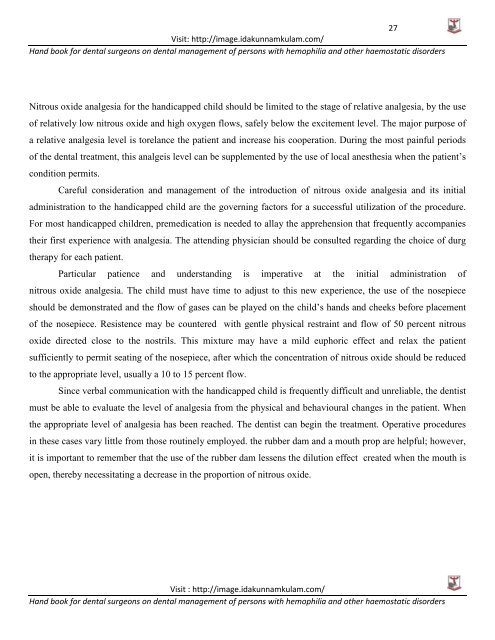hand book for dental surgeons - Indian Dental Association ...
hand book for dental surgeons - Indian Dental Association ...
hand book for dental surgeons - Indian Dental Association ...
Create successful ePaper yourself
Turn your PDF publications into a flip-book with our unique Google optimized e-Paper software.
27<br />
Visit: http://image.idakunnamkulam.com/<br />
Hand <strong>book</strong> <strong>for</strong> <strong>dental</strong> <strong>surgeons</strong> on <strong>dental</strong> management of persons with hemophilia and other haemostatic disorders<br />
Nitrous oxide analgesia <strong>for</strong> the <strong>hand</strong>icapped child should be limited to the stage of relative analgesia, by the use<br />
of relatively low nitrous oxide and high oxygen flows, safely below the excitement level. The major purpose of<br />
a relative analgesia level is torelance the patient and increase his cooperation. During the most painful periods<br />
of the <strong>dental</strong> treatment, this analgeis level can be supplemented by the use of local anesthesia when the patientís<br />
condition permits.<br />
Careful consideration and management of the introduction of nitrous oxide analgesia and its initial<br />
administration to the <strong>hand</strong>icapped child are the governing factors <strong>for</strong> a successful utilization of the procedure.<br />
For most <strong>hand</strong>icapped children, premedication is needed to allay the apprehension that frequently accompanies<br />
their first experience with analgesia. The attending physician should be consulted regarding the choice of durg<br />
therapy <strong>for</strong> each patient.<br />
Particular patience and understanding is imperative at the initial administration of<br />
nitrous oxide analgesia. The child must have time to adjust to this new experience, the use of the nosepiece<br />
should be demonstrated and the flow of gases can be played on the childís <strong>hand</strong>s and cheeks be<strong>for</strong>e placement<br />
of the nosepiece. Resistence may be countered with gentle physical restraint and flow of 50 percent nitrous<br />
oxide directed close to the nostrils. This mixture may have a mild euphoric effect and relax the patient<br />
sufficiently to permit seating of the nosepiece, after which the concentration of nitrous oxide should be reduced<br />
to the appropriate level, usually a 10 to 15 percent flow.<br />
Since verbal communication with the <strong>hand</strong>icapped child is frequently difficult and unreliable, the dentist<br />
must be able to evaluate the level of analgesia from the physical and behavioural changes in the patient. When<br />
the appropriate level of analgesia has been reached. The dentist can begin the treatment. Operative procedures<br />
in these cases vary little from those routinely employed. the rubber dam and a mouth prop are helpful; however,<br />
it is important to remember that the use of the rubber dam lessens the dilution effect created when the mouth is<br />
open, thereby necessitating a decrease in the proportion of nitrous oxide.<br />
Visit : http://image.idakunnamkulam.com/<br />
Hand <strong>book</strong> <strong>for</strong> <strong>dental</strong> <strong>surgeons</strong> on <strong>dental</strong> management of persons with hemophilia and other haemostatic disorders



